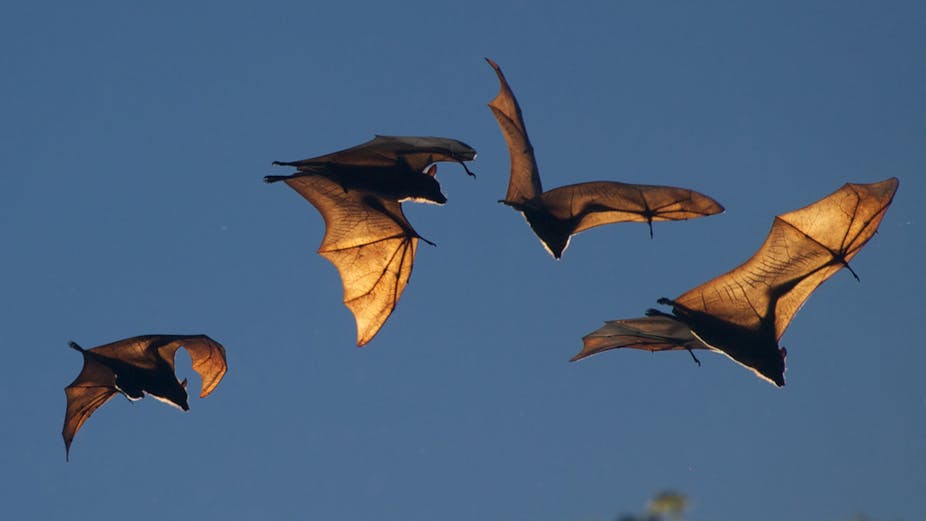This year has had the lot. First came the tempest, then the floods. Fires are on their way as the landscape dries out.
Now we have pestilence, in the form of Hendra virus. Calls for bat culls have ensued, but killing or relocating bats could make things worse for everyone.
Vital pollinators: bats carry more than diseases
Hendra virus is one of a number of recently emerged viruses which has spilled over from its usual wild-animal-hosts to domestic animals, and then to us.
Hendra’s repeated appearance this year has [caught public attention](http://www.theaustralian.com.au/national-affairs/hendra-virus-spreads-treatments-limited/story-fn59niix-1226094172689. Sadly much of that attention has not focused on the rarity of the disease or that transmission to humans occurs from exposure to sick horses.
Instead, it has focused strongly on control of the reservoir host of the virus: flying foxes.
Flying foxes are large bats found in forests along the whole of the east coast of Australia. They are important pollinators, and disperse the seed of native trees and shrubs.
In many environments, they are better at these tasks than birds, insects or the wind. In the wet tropics of northern Queensland, flying foxes help maintain the world heritage values of the tropical rainforest.
Cute, furry, useful and hated
Despite their ecological value, flying foxes are roundly disliked, especially by the citizens of towns which share space with a flying fox colony.
A recent paper by Dominique Thiriet analyses the effect of unpopularity on species management. Shorn of academic niceties, she concludes it is hard to “sell” the value of creatures people dislike and even harder to implement science-based management regimes that conflict with the wisdom of public opinion.
Each time a disease crosses from bats to humans, there are immediate and sustained demands for bats to be culled or relocated from their roost sites.
These are rash ideas. There is a growing body of research that suggests relocation or culling will not reduce bat-associated disease and may even make matters worse.
The basis for this argument lies in the wider domain of One Health, an idea which links human health and welfare to the health of the natural world.
Bat illness can lead us to the bigger picture
Overseas, spillover of viral diseases from bats has contributed to outbreaks of Nipah virus, SARS and Ebola virus. In each instance, the spillover has occurred in places with close associations between humans, their animals and bats in landscapes experiencing severe environmental stress.

In Australia, the excretion of Hendra virus by bats varies by space and time. Outbreaks of disease are most likely at times of nutritional stress and when there has been severe environmental disturbance. This has certainly been the case in northern and southern Queensland this year.
One Health suggests the solutions lie in dealing with the underlying drivers of disease emergence. By focusing on the bats we are missing the big picture and another warning that our environment is under duress.
Avoiding Hendra is easier than killing bats
Pending release of a vaccine against Hendra virus, managing the immediate risk to horses and humans is simple – follow simple hygiene and feed management practices that reduce horse and horse feed exposure to bats and their excretions.
This is the approach recommended by Biosecurity Queensland and the Queensland Horse Council.
This is because Hendra virus crosses to humans from infected horses, not from flying foxes, and the infection of horses takes place in the rural foraging range of the bats.
There is no incontrovertible evidence that harassing bats so colonies relocate increases rates of viral excretion. But the precautionary principle suggests the banging of drums, rattling of tins or roaring of engines is not a good idea.
Even if bat colonies do relocate, it is not clear how this will lower the exposure of horses in paddocks to flying foxes carrying Hendra virus.
Harassment and colony relocation has other limitations. Re-locating a bat colony is not easy: re-located bats often end up in places they are wanted even less. It is even less easy to be sure that when bats depart they do so as a result of the dispersal and not simply to follow the flowering of food trees.
Culling flying foxes is equally dubious. It is practically impossible to cull enough to reduce flying fox populations to a level acceptable to communities. If pursued, the risk of increased virus secretion as a result of stress is real and the public health benefit minimal.
Ignoring science won’t cure disease
Culling is cruel. Studies of bats shot under permit in NSW orchards show that most died slowly. Many of those shot received debilitating wounds which resulted in death by starvation. This is not consonant with contemporary standards of humane treatment of animals.
And finally, removing animals that play key roles in the functioning of healthy ecosystems is certain to have wide-ranging but unquantifiable long-term effects on our agro-ecological support systems.
Some sections of the community are increasingly sceptical about scientific approaches to significant and contentious issues. Wilfully dumbing-down complex problems is a hallmark of this scepticism.
This attitude will continue to be a challenge to developing best practice biosecurity regimes in response to Hendra virus. More importantly, it may undermine our best efforts to deal with major drivers of disease emergence such as habitat loss.

